| Earliest known ancestor of Group 36 | |
| Robert Chandler, b Connecticut USA 1761, d Pennsylvania USA 1831 | |
The Unknown Chandlers
 The known history of Chandler Family 36 – the 36th genetically distinct Chandler family encountered by the Chandler DNA project – begins with Robert Chandler (1761-1831), Revolutionary War veteran, now documented in my recently approved applications with the Sons of the American Revolution as ancestor #P-329505 and, for my daughter, with the Daughters of the American Revolution as ancestor #A020700. The history of this Chandler line, a “previously unknown” genetic family, according to CFA Vice President Dick Chandler, was researched by Lola Adeline Shepard in her 1931 DAR Application for Robert Chandler, but his personal background and roots have remained a mystery to this day, more than 80 years later! That mystery keeps drawing me and other family researchers back to this apparently humble man who served his country over six long, dangerous years and went on to sire this “unknown” branch of the Chandler clan.
The known history of Chandler Family 36 – the 36th genetically distinct Chandler family encountered by the Chandler DNA project – begins with Robert Chandler (1761-1831), Revolutionary War veteran, now documented in my recently approved applications with the Sons of the American Revolution as ancestor #P-329505 and, for my daughter, with the Daughters of the American Revolution as ancestor #A020700. The history of this Chandler line, a “previously unknown” genetic family, according to CFA Vice President Dick Chandler, was researched by Lola Adeline Shepard in her 1931 DAR Application for Robert Chandler, but his personal background and roots have remained a mystery to this day, more than 80 years later! That mystery keeps drawing me and other family researchers back to this apparently humble man who served his country over six long, dangerous years and went on to sire this “unknown” branch of the Chandler clan.
Growing up in the Catskill Mountains in upstate New York in the 1960’s in the very, very rural hamlet of Barryville, I became aware of a series of newpaper articles from the 1950s called the “Basket Letters”, written by Leslie LaValley and published in the nearby Hancock, New York, Herald. LaValley wrote about the early settlers of the Rock Valley, New York, area which is nestled along the Delaware River and the Pennsylvania border just north of Barryville.
Our family had kept copies of several of the articles which discussed at length the Chandlers of the “Basket”(Basket Creek area). For many years I read and reread those articles. As with most folks, I was busy earning a living and helping raise a family until I retired last year from a national sales role in the paper industry that had taken me to all corners of the country over the last 30 years. The collection of newspaper articles was eventually reprinted in book form in 1990 by the Basket Historical Society of the Upper Delaware Valley. Once I had access to the book and the complete collection of articles, I found many other mentions of our Chandler family.
Of course, the articles discussed many other families in that area as well, but I kept coming back to a comment about Robert Chandler in Chapter 62 of the book: “Robert, so the story goes, was a veteran of two wars. He tried to join the Continental Army in the Revolutionary War, but was too small to carry one of those long muskets they shot then,  so they gave him a bucket and made him a water boy. In the War of 1812 he served as a Surgeon”.
so they gave him a bucket and made him a water boy. In the War of 1812 he served as a Surgeon”.
After many months of research I have concluded this comment was based either on Robert not telling his children of the horrors of the war, just as many of us have seen with friends who came back from Vietnam or Iraq/Afghanistan, or an attempt at humor. Robert’s experience at Valley Forge alone would have been enough to run off most, yet he served his country loyally for six years during its difficult birth, apparently including at the Battles of Monmouth, Stony Point, and Yorktown.
This chapter and others in the Basket Letters were based on interviews of my ancestors in that region in the 1950s, and of course they had only family history to rely on. I have used that book’s genealogy comments as a map over the last 18 months, and so far everything they said has proven true (although I still lack proof of Robert’s service in the War of 1812).
As I look back, I am quite surprised that, other than some photos, we had almost no printed Chandler family history or even oral history except for the newspaper articles. I guess my parents, during the Great Depression and afterwards, were more focused on survival and raising a family than discussing the past. I may never know for sure how much they did or did not know. However, each new fact I am able to document is a piece of history for my descendants.
For years I told myself I would investigate this when I had time. When I retired in early 2012, it became a priority. I decided that the initial goal would be official documentation registered with the SAR and DAR for my children, other family members, and future generations. I will not go into details of this as many of you have been through this process with your own branches. Let’s just start with the family history as it is known and accepted by these two respected organizations.
Robert Chandler’s existence was first documented when he was 15 years old in a July 1776 Guardianship Agreement executed in Pomfret, Connecticut, by Charles Church Chandler (no relationship proven), a Justice of the Peace in Woodstock, Connecticut. Pomfret was the county seat at that point. I am told that, given Robert’s age, he would have picked his own guardian, who was Jedediah Morse, grandfather of Samuel Morse of telegraph fame, as well as a Deacon in the local Congregational Church.
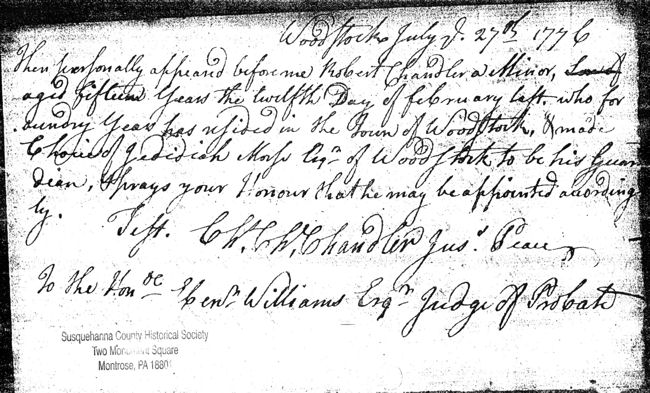
|
Charles Church Chandler and Jedediah Morse were fellow Woodstock Justices of the Peace, Deacons of the Congregational Church, and apparently fervent Patriots. (Woodstock was a hotbed of Revolutionary support.) This appears to indicate some sort of arranged placement of Robert as a personal favor to someone. It must be said that the finder of this document was unable to find evidence that this Robert is our Robert Chandler, but equally no evidence has been found to discount it, especially in light of the almost complete lack of anyone with that name in New England at that time on any digital reference seen to date.
Of Robert’s parents, no reference or trace has been found, or documentation of where he originated. Oddly, the Guardianship agreement has “the son of” crossed out and unfilled. Perhaps Robert was the son of a Loyalist or other controversial figure that Charles Church Chandler felt best not to mention in this document for fear of disapproval by his legal superiors. I have found in my research that Robert was a common name in the South, but very rare at the time in New England. In addition, I have no proof that Chandler was even his real name. Several researchers feel he took the surname of Charles Church Chandler (the JP in Woodstock who arranged the Guardianship) out of respect for him and a desire to hide his real surname, but again there is no proof of this to date.
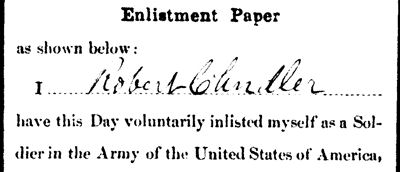 Less than a year after the date of the Guardianship Agreement, in April 1777 Robert enlisted in the Continental Army (2nd Regiment, Connecticut Line), perhaps stimulated by Jedediah and Charles’ fervor or other unknown influences. (Click on the image at right to see the full 1777 enlistment card.) Robert’s first notable service was likely with his unit (which was assigned to Washington’s Corps) in the Philadelphia Campaign of the fall of 1777 including the Battles of Brandywine, Germantown, and Whitemarsh, before ending up at Valley Forge in the brutal winter of 1777/8. Imagine my surprise and delight on finding Robert in Valley Forge’s List of Patriots! I had been to Valley Forge on a family visit years before with my children, but had no idea I had family ties to this historic site.
Less than a year after the date of the Guardianship Agreement, in April 1777 Robert enlisted in the Continental Army (2nd Regiment, Connecticut Line), perhaps stimulated by Jedediah and Charles’ fervor or other unknown influences. (Click on the image at right to see the full 1777 enlistment card.) Robert’s first notable service was likely with his unit (which was assigned to Washington’s Corps) in the Philadelphia Campaign of the fall of 1777 including the Battles of Brandywine, Germantown, and Whitemarsh, before ending up at Valley Forge in the brutal winter of 1777/8. Imagine my surprise and delight on finding Robert in Valley Forge’s List of Patriots! I had been to Valley Forge on a family visit years before with my children, but had no idea I had family ties to this historic site.
Robert went on from there to serve three long years, and then re-enlisted for three more, probably seeing action with his unit at the Battles of Monmouth, Stony Point, and Yorktown. He finally left the service, still a private, on medical discharge in 1783.
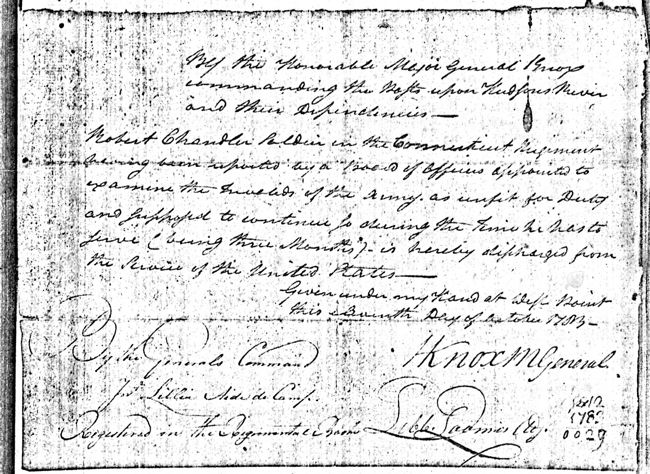
Robert Chandler from further service to the United States army,
apparently because his health has made him “unfit to serve.”
At this point he disappeared from any written records (at least those located so far) until his 1788 marriage in Woodstock, Connecticut, to Sarah Walker. In Woodstock Vital Records, a notation states, “Dr. Robert Chandler, late of Woodstock & Sarah Walker of Woodstock were married in Woodstock January the 17th 1788”. Apparently he used the five years to become a doctor, reportedly of “Roots and Cancer”, but no trace has been found of who, if anyone, he apprenticed under. There is some suspicion that, due to his reported small stature, he may have spent at least some of his Continental Army time serving with the army’s physicians and surgeons, but again no proof exists of this. Albigence Waldo of Woodstock, Connecticut, was the Surgeon General at Valley Forge, so they may well have known each other, but again no documentation has so far been found to confirm this.
In an attempt to “reverse engineer” an answer to Robert’s origins, I have done a DNA 37-marker test with the Chandler DNA Project, which was useful mostly in confirming who I was not related to. For some time I had been convinced that John Chandler, the “Honest Tory” (so named because his claims for compensation from the government on returning to England were not exaggerated, as many were), was Robert’s sire, but that was ruled out by the test and Chandler Family Association records (John being a descendant of William and Annis Chandler – genetic family #9). The DNA test result also confirmed that I share no bloodlines with any of the New England Chandler families on whom the CFA currently has descendants’ DNA data.
 A previously unknown distant cousin, a descendant of Ezra Chandler (another of Robert’s sons), was originally my only direct match in the Chandler DNA Project database. His ancestors had gradually moved cross country, reaching the Portland, Oregon, area. Before his death in 2007, his daughter asked him to supply a DNA sample. (Direct, named, male descendants make the best genetic candidates.) I had no previous knowledge of this family, but they and others are documented in Jeannette Chandler Murray’s wonderful book The Family and Descendants of Dr. Robert Chandler. In 2004 Jeannette organized the Veterans Administration placement of a new gravestone at Robert’s gravesite in Gibson.
|
My DNA was a direct match with Ezra’s descendant and the only direct match at that time – a disappointment, as I was hoping for many. But two matching people were sufficient to create Chandler Family 36 in the Chandler DNA Project. Hopefully more will test in the future. I appreciate the CFA’s support in current and future investigations of our “unknown” branch.
There have subsequently been two more direct matches to my DNA with members of the Morey family (a very old English clan), but in spite of significant efforts by the CFA (Dick Chandler and others) and Morey genealogists who have contacted me, the specifics of the generational link is unknown at this time. There is a connection of some significance, but the time frame is unknown. I am upgrading my DNA 37 marker test to DNA 67 markers in order to improve comparisons of our Chandler DNA with the Morey clan.
Robert and Sarah stayed in the Woodstock area only briefly. She was actually from nearby Killingsly and her family had deep roots in Bristol, Rhode Island, previous to her birth. Apparently drawn by the Beekman Patent Land Grant, Robert and Sarah moved to the Pawling, New York, area, where he served as a doctor until sometime after 1801 when they moved with their children to Gibson, Pennsylvania. Several more children were born in Gibson. Their children were:
- Abigal 1788-1858
- Charles 1790-1855
- Polly 1792-?
- Henry 1795-1871
- George 1797-1855
- John 1800-1878 (my ancestor)
- Betsey 1803-1861
- Ezra 1806-1858
- Thomas 1810-1858
Small items of family news gleaned from their time in Gibson:
- “In 1804 or 5, Dr. Robert Chandler, first P.M. [postmaster] at Gibson Hollow, occupied the Skyrin House.”
- “Dr. Chandler exchanged this place with Mr. Drinker for wild land, and resided until his death in 1831, about half a mile east on the turnpike.”
- “1804. Robert Chandler at Gibson, a Roots and Cancer Doctor of considerable practice.”

will appear in a separate window. Close that window to return to this page. |
Robert and Sarah settled in there for the rest of their lives. As well as being a doctor, Robert became the first postmaster, serving until about 1825. Robert died in 1831 and Sarah around 1815. Robert remarried to a lady named Rhoda sometime after Sarah’s death. Most of Robert and Sarah’s children stayed in the area and raised families.
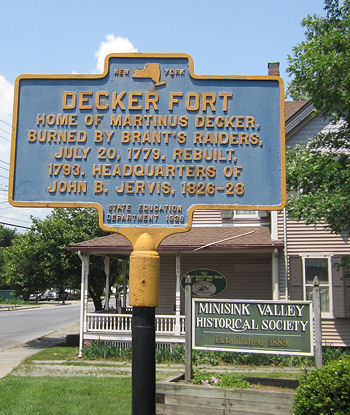 In May 1827 my ancestor, Robert’s son John, married Catherine Decker, originally of the Port Jervis, New York area. The Decker and Chandler families apparently became friends in the Pawling/Port Jervis area and moved together to the Susquehanna County, Pennsylvania, area, showing up next to each other in the Federal Census. I (and other researchers) believe Catherine is the great-granddaughter of Martinus Decker, who served in the New York Militia in the Revolution and fought Col. Joseph Brandt, a Dartmouth-educated Mohawk Indian. Brandt led British troops in the Port Jervis area, notably in the Battle of Minisink in 1779. Fort Decker, a Revolutionary War fort, now headquarters for the Minisink Valley Historical Society, is named for Martinus. Martinus’ American Frontier story is told in Perseverance and Vigilance: The History of the Decker Stone House by Peter Osborne, published in 1997.
In May 1827 my ancestor, Robert’s son John, married Catherine Decker, originally of the Port Jervis, New York area. The Decker and Chandler families apparently became friends in the Pawling/Port Jervis area and moved together to the Susquehanna County, Pennsylvania, area, showing up next to each other in the Federal Census. I (and other researchers) believe Catherine is the great-granddaughter of Martinus Decker, who served in the New York Militia in the Revolution and fought Col. Joseph Brandt, a Dartmouth-educated Mohawk Indian. Brandt led British troops in the Port Jervis area, notably in the Battle of Minisink in 1779. Fort Decker, a Revolutionary War fort, now headquarters for the Minisink Valley Historical Society, is named for Martinus. Martinus’ American Frontier story is told in Perseverance and Vigilance: The History of the Decker Stone House by Peter Osborne, published in 1997.
The Decker name appears at least three times in my Chandler line, but final confirmation with the SAR and DAR of Catherine’s parentage awaits proof of a final generation of linkage that I have not yet been able to adequately document. None of my siblings (including my brother, Stuart Decker Chandler) can otherwise account for the honoring of the Decker name by any family history they have been told over 80 years.
My direct ancestor John Chandler and wife Catherine raised 13 children in Clifford, Susquehanna, Pennsylvania, and John built a sawmill there about 1830. Just after the census of 1850, John and his family packed up and moved fifty miles east to the virgin timber in Rock Valley, New York, where he built the first sawmill on Basket Creek. There were eventually seven sawmills in the area.

Ruins of the foundation of John Chandler’s sawmill
According to the Centennial History of Susquehanna County, Pennsylvania, John Chandler and his large family ended up in Deposit, the largest town near Rock Valley. Catherine and John had two more children in Rock Valley. Many of their children married into other settler families in the area. John died in 1878 in Rock Valley (though his grave location is not known) and Catherine some years later. John and Catherine’s 15 children were:
- Martin 1827-1876
- Huldah 1829-
- Hester 1831-1899
- Helen 1833-1920
- Marvin 1835-1916
- John 1836-1867
- Harriet 1838-1840
- Harrison 1840-1862
- Elizabeth 1842-
- Alvah Melvern 1844-1917 (my ancestor)
- Lola 1845-
- Margery 1846-1897
- Jane 1848-1916
- Philanda 1850-1850
- Nelson 1853-1928
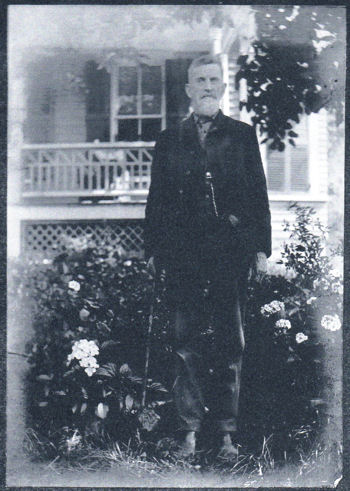
After returning from years of service in the 143rd New York Infantry Regiment during the Civil War (including with Sherman at the burning of Atlanta), my ancestor, Alvah Melvern Chandler, took over the Chandler Sawmill. On their return, two of his brothers, Marvin and Martin settled in Rock Valley; two others, Harrison and John, died of disease contracted in the Civil War and are buried in unmarked graves in the abandoned Basket Cemetery, in front of the site of “the Old Red Schoolhouse”. This is where Alvah later met his wife, Jennie Watson, who was the schoolteacher there. They married in June 1868.
Due to the lack of industry in the area, various occupations were undertaken to raise cash, including farming, maple syrup production, and rafting timber down the Delaware River. Large virgin trees were logged and skidded down to the river in the winter, assembled into large log rafts on the frozen river, and floated downriver to Philadelphia when the ice melted in the spring. Those riding the logs down river would sell them, and then walk home about 120 miles to Rock Valley!
The Basket Letters articles by Leslie LaValley, compiled into a 90-chapter book in 1990, recount many daily adventures in the Basket Creek region in the 1850-1930 period, including social life and such sporting adventures as trout fishing and deer hunting.
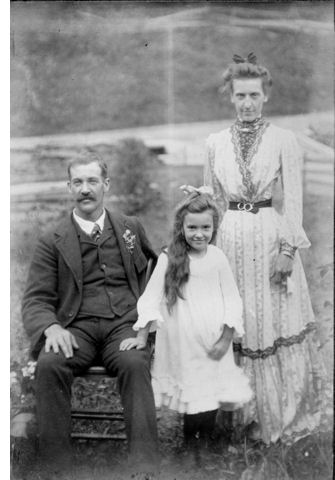
After my ancestor Alvah Melvern Chandler married the local ‘Red Schoolhouse’ teacher Jennie Watson, they raised six children in the area, including my grandfather who I never met, Decker Alvah Chandler (1881-1949).
Alvah Melvern and Jennie’s children were:
- Edwin Herbert 1870-1944
- LaForest 1872-1933
- Theodore 1878-
- Decker Alvah 1881-1949 (my ancestor)
- Jennie Agatha 1885-1950
- Lyman Bell 1888-1939
Alvah remarried, after Jennie’s death, to Eugenie Collins.

After the 1930s, with various nearby Catskill Mountain villages such as Hancock, Deposit, and Callicoon becoming larger towns, jobs drew the family members away from sleepy Rock Valley, which must have been hit hard during the Great Depression. Decker Alvah Chandler, our ancestor, followed in his father’s footsteps as a sportsman but abandoned the sawmill business. After the Chandler sawmill – the last one in that area – closed about 1910, he was employed by the local Erie Railroad where he worked most of his career, with the only other stop being putting in the first local telephone system.
Decker married Lena Oestrich of Rock Valley. Her parents were originally from Austria via years in Germany. Decker’s generation was the first since John Chandler moved to the area in 1850 to leave Rock Valley to find work.
Decker and Lena’s children were:
One of Decker and Lena’s three children, Ralph Decker Chandler (1909-1982), was my father. He married Violet Elizabeth Knapp of Deposit, his high school sweetheart, in 1933. Father made a career in the poultry business, selling successfully during the Depression and going on in the late 1930s and 40s to build a classic mid-20th century entrepreneurial company based in Shohola, Pennsylvania (across the Delaware River from Barryville), finally closing the doors in 1970. 
|
After beginning a teaching career in Ohio, my mother Violet became a full time mother, and they raised me and four siblings: my sisters Carolyn, Janice, Linda and my brother Stuart, with me being the baby of the family. Now there are 17 children between us all, and numerous grandchildren.
I left the Catskill Mountain region for good in 1970, moving to the Adirondacks for school and work, then in 1980 work took me on to the heart of the old Confederacy – Mobile, Alabama. In Mobile I met my wife Cindy. We married in 1981 and raised our children Kate Elizabeth and Alex Grady, who with his wife Emily just had our first grandchild, Scarlett Kennedy Chandler.
On my summer 2012 return to the Basket Creek area to retrace family roots after 30 years, I was struck by the economic desolation of the area compared to when I had left years before – a sad commentary on this and many similar rural regions in the U.S. now.
Should any of the readers of this article have information to add on the Robert Chandler origination mystery, please contact the writer at  .
.
Sources:
- Chandler-Burks Family Tree on Ancestry.com.
- Pomfret Probate District, 1776, #938 Estate of Robert Chandler of Woodstock (Guardianship Agreement).
- Woodstock (Conn.), Vital records of Woodstock, 1686-1854 (Hartford: The Case, Lockwood & Brainard Co.), 362, available online at //archive.org/stream/vitalrecordsofwo00wood/vitalrecordsofwo00wood_djvu.txt
- Doherty, Frank, The Settlers of the Beekman Patent: an historical and genealogical study of all the 18th century settlers in the patent, Volume III, Chapter 23: “The Chandler Family”, (Pleasant Valley, NY: New England Historic Genealogical Society: F.J. Doherty, 1995), 353-355.
- Murray, Jeanette Chandler, The Family and Descendants of Dr. Robert Chandler (self published by Jeanette Chandler Murray –
 , 2004).
, 2004). - LaValley, Leslie, Basket Letters: A History of that Mountainous Region of the Upper Delaware that was Once Known Only as the South Woods and the Wilds of the Basket, published 1990 in book format by the Basket Historical Society of the Upper Delaware Valley, Delaware County (NY).
- Blackman, Emily C., History of Susquehanna County by Blackman — History of Susquehanna County, Pennsylvania: From a Period Preceding Its Settlement to Recent Times, Including the Annals and Geography of Each Township with Maps and Numerous Illustrations ; Also a Sketch of Woman’s Work in the County for the United States Sanitary Commission, and a List of the Soldiers of the National Army Furnished by Many of the Townships. (Susquehanna County PA: Claxton, Remsen, & Haffelfinger, 1873), pp. 196, 197, 205, 210, 553, available online at //tinyurl.com/y7lttbxu.
- Stocker, Rhamanthus Menville, Centennial History of Susquehanna County, Pennsylvania, (Susquehanna County, PA: Regional Publishing Company, 1974), 754, 793, 796, 797.
- Osborne, Peter, Perseverance and Vigilance: The History of the Decker Stone House (Minisink Valley Historical Society), 2, 3, 33, 58, 64-69.




